To the wonderful people of Ladysmith, Wisconsin : We're thinking of you !
This small community was devastated by a tornado on the afternoon of 02 September 2002
An Historical Tale of Titantic Proportions
This document was last updated on 22 October 2012 (Ver. 1.4)
Although there were old photographs and newspaper clippings in the Nelson family collection for years, this research project began for me in 1964, when I discovered several bushel baskets of machine parts in my grandparents' farm attic. The next eight years were spent restoring the equipment to working condition and researching its history, which continues today. For other members of my family, however, the story really begins around 1903.
Greg Nelson, Lincoln, Nebraska.
Here's my story, including graphics, which establishes a strong connection
between events in the Nelson family and the recent film, Titanic.
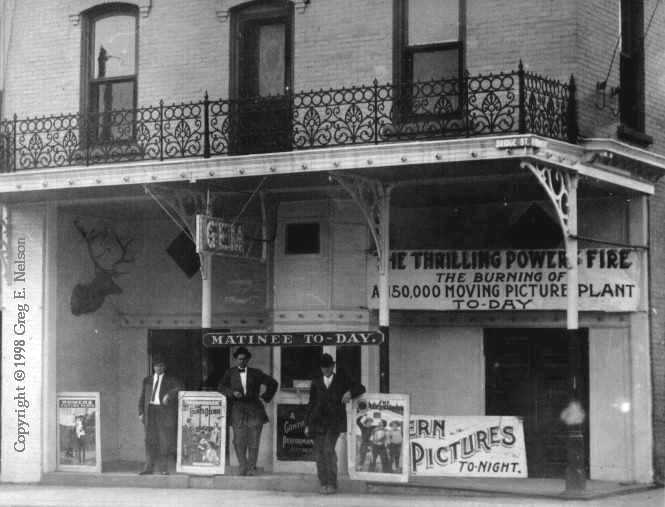
Enon Nelson (right) and two unidentified men.
Welcome to the Gem Theatre, Chippewa Falls WI, ca. 1912. Today's matinees include Oh! Baby (Powers, 25 July 1911), THE COURTS DECREE (Thanhauser, 7 July 1911), and
THE TABLES TURNED (Independent, 17 February 1912), while "The Thrilling Powers Fire" (Powers, 25 July 1911) may refer to the incineration of their movie studio on 6 June 1911. (Personal correspondance, George C. Pratt,George Eastman House, Rochester NY 14607, 31 January 1972) (See closeup below). The Independent Film Company was founded by Carl Laemmle, a former Wisconsin silent film exhibitor, who expanded his organization into Universal Pictures later in 1912. Thanhauser and Powers were absorbed into Universal about the same time. (Personal correspondance, Paul Spehr,
Library of Congress film historian, 15 December 1971). According to John Myrman of Chetek Wisconsin, the first Gem Theatre was located on the corner of Willow and Bridge Streets, about 1911 - 1912. The second Gem Theatre was located on the corner of Grand and Bridge Streets, and was there until it burned down in late 1913 or early 1914. (Personal correspondance, 3 January 1972). Note : Perhaps this photo was taken in Ladysmith. Can you help me find out?
Carl Leidholdt confirmed the Gem was located on Bridge Street, across from the Stanley Hotel. He wrote that both buildings burned just prior to World War I. Where the Gem was located later became a drug store and is now (1972) the Boston Clothing store, sometimes called the Physicians Block as there are doctor's offices on the second floor. He recalled going to the Gem theatre only once, to hear a neighbor boy sing between pictures. Leidholdt went into the badly burned orchestra pit and learned how they made the sound of horses hoofs. (Personal correspondance, 1 January 1972).
Eli had a company of troops that went around the state playing movies in small towns. The movies were free to the public and paid by businessmen to bring in the rural trade. (Personal correspondance, 1 January 1972).
Enon Nelson (1882 - 1965) apparently took the Edison PK machine on the road, with his new wife, Olga Borgen Nelson. She recounted a story saying that "There were four ways of putting a film in the projector, and I managed to get it inside out and upside down." (Personal conversation, 1970). Among Enon's personal effects were two small personal planners (calendars) listing small towns in Wisconsin and Minnesota, with dates ranging between Nov. - Dec. 1916 and July - August 1917. Most of those communities have disappeared from modern road maps, illustrating the mass exodus from farms and rural communities to larger towns. Assistance to finding an old railroad map of WI, early 20th century era, would be appreciated.
Grandpa Enon told me that occasionally he used 'pressed gas' to illuminate the silent films, or used two electrodes plunged in a bucket of salt water to regulate the direct electric current. Sometimes, the silent films were shown on the side of a building, or on a large bed sheet. Projecting the silent films near the railroad tracks enabled him to use power from the railroad system. (Personal conversations, 1964 - 1965). Considering the fact that the nitrate film was highly explosive, it's amazing no one in my family was killed during those early days of silent film presentations! Studio fires and movie house fires were not that uncommon. Among our family archives is an undocumented photo of a huge hole in a city block, where a building had once stood. Was this the site of the Gem Theatre, which burned to the ground in 1913-14, according to John Myrman? He wrote that Eli Nelson (1884 - 1965) started his tent movie show in 1919 or 1920. (Personal correspondance, 27 January 1972)
Which Gem Theatre is this?
Here's an old newspaper clipping, which has been in the family for over seventy years:
GATHERS GEM FORCE What's on the back of this clipping?
Mgr. Nelson Getting a Notable Staff in Pre-
paration for Grand Opening Monday
Manager Eli Nelson who takes who takes
charge of the Gem Theatre next
Monday is planning a nice entertain-
ment hall for this city. The other
day Mr. Nelson was joined by his
brother Enon Nelson from Yellow-
stone Park where he has been em-
ployed as a musician for sometime
past. Then John Lundberg, of Chi-
cago is here as pianist and Elmer
Danielson, also of Chicago, will be
the machine operator and electrician.
And today Victor G. Whittier, a
well known musician from Rice
Lake came and he is a tenor singer
of some note and he will sing the
illustrated songs. Critics consider
Mr. Whittier to be a promising artist.
The young man is well known in
high school and college circles, hav-
ing recently attended the University
of Chicago. Chippewa Falls patrons
may congratulate Mgr. Nelson for
securing so promising a singer. Mr.
Whittier is a bright and ambitious
youth who will no doubt make good.
Mgr. Nelson is a musician of note
himself. He was until last month a
member of the famous Innes band,
which annually tours the country.
Mgr. Nelson was a solo trombone
player and he has been sitting in
Prof. Altman's band, greatly inspir-
ing the band members with his fine
playing. He will organize an orches-
tra at the Gem to play every even-
ing. And the Gem will be rearrang-
ed, newly decorated and made more
convenient in every way for the pa-
trons. At the big opening next Mon-
day night the Gotzian band will play
at the corner prior to the first per-
formance.
As a testimonial of Mgr. Nelson's
musical ability it may be remarked
that he holds a scholarship from the
New York Musical Institute which
has tendered him as a testimonial
to his skill playing band instru-
ments.
In the summer of 1997 (Northern Hemisphere case), I spent several hours in the Chippewa Falls Public Library's microfilm archives, trying to track down the exact publication date of this story, so far without success. In August 2005, I spent a few minutes in the Chicago Public Library looking for these Chicago references, so far with limited results. Stay tuned !
Here are some unanswered questions regarding the Gem Theatre story:
When was this story published?
In what newspaper was it published?
Was the GEM really in Chippewa Falls?
What became of these individuals?
If you can shed any light on any part of this story, please contact the author right away.
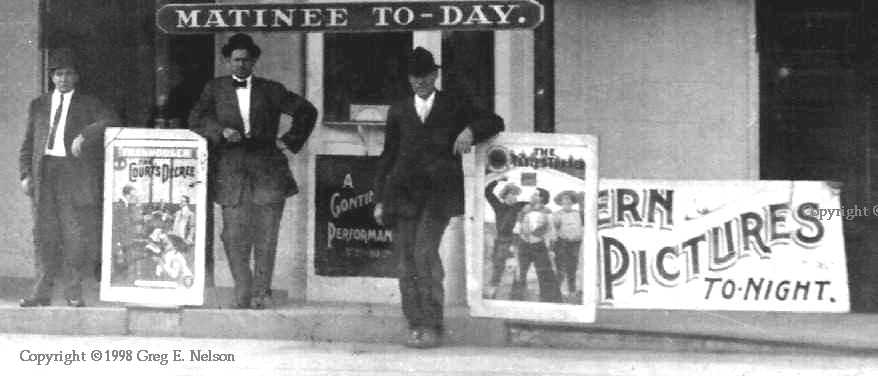
This closeup shows Enon Nelson (R), and two unidentified men in front of The Gem Theatre, Chippewa Falls WI. Marge Berard of Washington MO thinks the man in the middle is Eli Nelson, her father. (Personal conversations, 1996 and 2004). Thanks also to Celse Berard, Eli's grandson, who has recently (August 2004) been in touch.
John Myrman wrote that he watched movies at the Gem, including THE ROBBING OF THE OVERLAND EXPRESS. (Personal correspondance, 3 January 1972). Mr. Carlson confirmed Mr. Myrman's recollection that the New Gem Theatre was located across the street from the Old Stanley House or Hotel, in the old Rod Carroll Building, on the corner of Bridge and Grand Streets. Mr. Harry Hall and Mr. Joe Nolan put on a popular vaudeville act here about a Swede and an Irishman. Mr. Myrman ran the local pool hall, smoke shop and soda fountain, where Eli would frequent when he was in town during the winter months. (Personal correspondance, 27 January 1972)
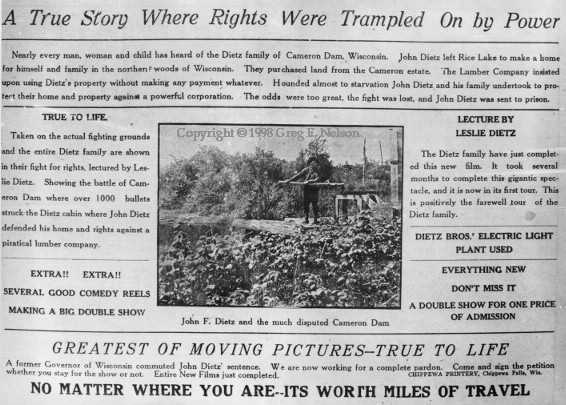
"A True Story Where Rights Were Trampled On by Power"
This shows side 2 of the DIETZ BATTLE flyer. John Dietz and his family moved to northern Wisconsin where they purchased part of the Cameron estate, but the evil Lumber Company trampled the rights of the hard-working family, hunted them down and forced them off their land, ca. 1910. Leslie Dietz recounted the family version of events in his lectures around the region.
Clearly, this was an emotional story, of corporate greed grabbing property without compensation, of the growing conflict between wealth and poverty, and political intrigue. Continue reading for more on this fascinating period in northern Wisconsin history.
What wasn't mentioned in the press at the time was the terrible environmental destruction of northern Wisconsin forests, as seen in photos taken during that era.
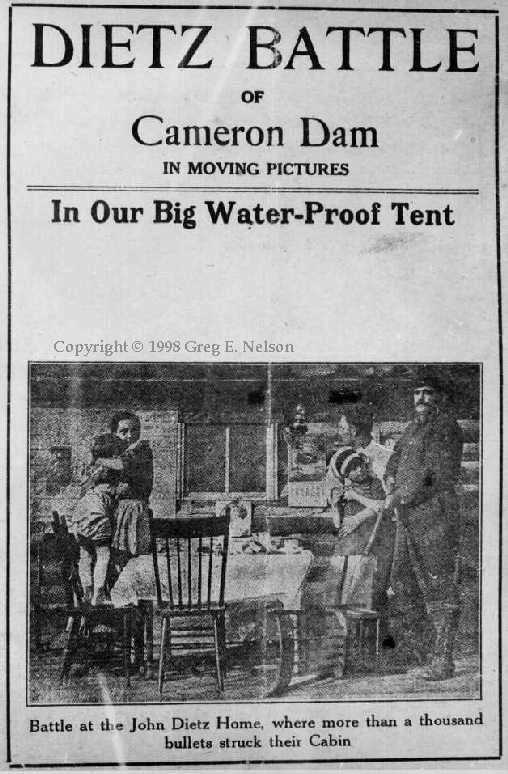
Here's a closeup of the DIETZ BATTLE film flyer, side 1.
According to John Myrman, Eli Nelson had a movie tent show which traveled throughout Wisconsin, Minnesota and the Dakotas in the 1920s. Apparently, his brother, Enon Nelson, would join him from Nebraska.
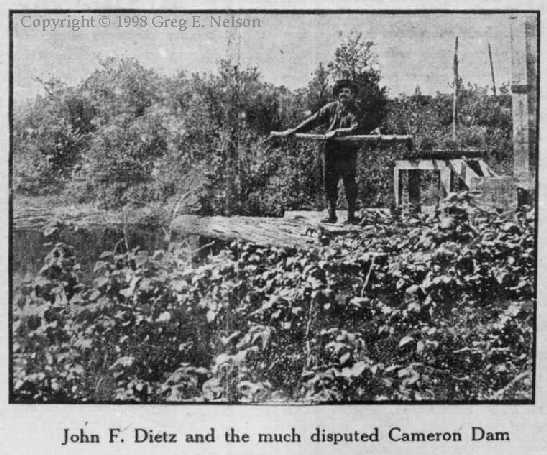
Here's a closeup of John F. Dietz, from the DIETZ BATTLE film flyer, side 2.
In 1972, John Myrman of Chetek WI, wrote that Stanley Carlson of Chippewa Falls played the part of Leslie Dietz. Mr. Carlson later moved to Wausau and drove a bus. (Personal correspondance. According to Paul Spehr, Motion Picture Specialist at the Library of Congress, there is no official record of the Dietz film. (Personal Correspondance, 1 May 1972).
The Machine : Edison Projecting Kinetoscope (1903)
Readers of this web page will be pleased to learn that the PK was appraised on 10 July 2004 by Nick Hawkins of Skinner Inc. for PBS' Antiques Road Show, Omaha NE. Be sure to watch for the PK on PBS in early 2005. Details of this event will be available here in the fullness of time.
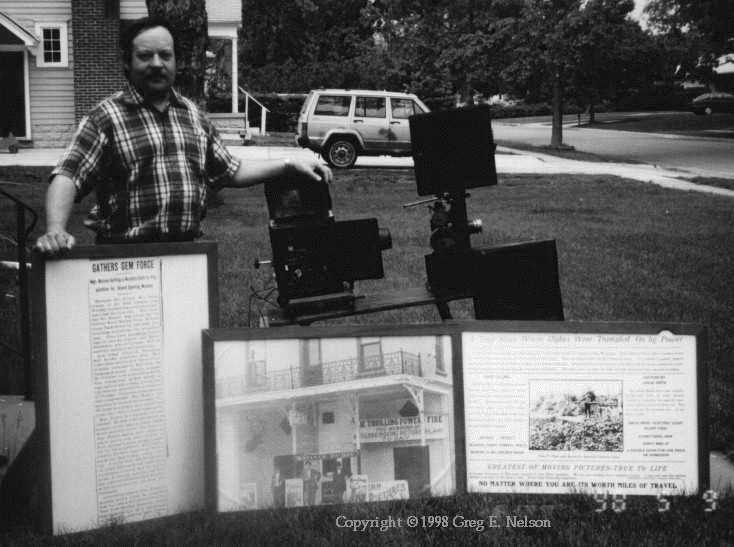
Putting it all together
Greg E. Nelson. shown here with his grandfather's Improved Exhibition model, Edison Projecting Kinetoscope silent film projector (patents 1897 - 1903), and some posters announcing the opening of the Gem Theatre (ca.1909 - 1912), a photo of the Gem owners/operators (ca. 1912), and the DIETZ BATTLE OF CAMERON DAM flyer, side 2 (date unknown). None of the patents listed on Edison's machine are attributed to him. This Edison projector uses 35mm film, as do most modern motion picture projectors of today. It is currently set up to utilize an AC carbon arc lighting system.
The two films shown on this machine include Lubin's version of THE GREAT TRAIN ROBBERY (1904) and D.W. Griffith's THE LONELY VILLA (1912). As early as October 1888, Thomas Edison filed his first motion picture caveat, describing the new technology as "...an instrument which does for the eye what the photograph does for the ear...this apparatus I call a Kinetoscope '"Moving View'" (Neal Baldwin, Edison : Inventing the Century, Hyperion, New York NY, (c) 1995) The photo shown here was taken in May 1998.
Edison's first movie camera, his 1889 Strip Kinetoscope, utilized a film transport system which pulled the film through the projector horizontally, as the IMAX movie system uses today
. His original machine is on display at Edison's Laboratory National Historic Site in Menlo Park NJ. (LOC photo ENHS # 6571). When I visited this site in 1981, they had several old Edison movie projectors, but none of them were complete or in working condition. Click here to visit the National Park Service
"Teaching With Historic Places" web site.
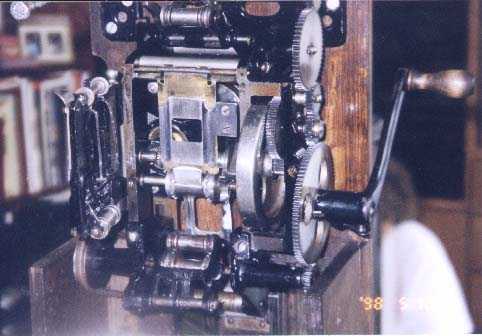
Here's a closeup of the film gate mechanism,
showing where the 35mm film travels as it passes past the film gate. The film moves from top to bottom in this view. The lamphouse (see next photo) is to the left.
It was no accident that Enon Nelson and his family drove the 400 miles (648 km) in their Model T from Big Springs to Omaha to see the first talking movies, THE SINGING FOOL and THE JAZZ SINGER, 1927. Viewing his first movie at the Orpheum Theatre in Omaha had quite an impact on my father, Byron, who was a teenager at the time. (Personal conversation, 1966)
Lucille Jacobs, of Ladysmith, in a letter to Beaulah Pearson, wrote that she (Lucille) recalled the Gem Theatre was 'across the street from the Gerard Hotel and across from the old Unique Theatre, next to Al Sabin's house, currently a bowling alley.' The problem is that she recalls the Gem Theatre as being in Ladysmith, Wisconsin. Ms Jacobs also recalled the conversation she had with a man on a passenger ferry between Prince Rupert BC and Ketchikan AK (when Anne lived there). This man said to her, "I see you were born in Chetek, Wisconsin. I was born in Cameron, Wisconsin. I just wondered if you remembered my dad showing moving pictures in a tent in Ladysmith" Ms Jacobs said she did remember the moving pictures but didn't recall the man's name. She wrote that the Gem building is still there, near Ruth McDonald's, owned by the VFW, and in excellent condition, including a new heating plant. (Personal correspondance, 3 February 1972).
John Myrman told a story on himself and revealed an important piece of family lore. He recalled that Eli Nelson would go fishing on Lake Wissota near Ladysmith during the winters. Once, while Eli was gone, John replaced Eli's minnows with wieners, enabling Eli to catch a beautiful 14 pound Northern the next morning. "He never knew who put the wieners on the hooks. That fish bit the index finger on his left hand which caused a stiff joint, so Eli could no longer play the violin." (Personal correspondance, 27 January 1972)
That little bit of history confirms Eli's interest in the violin, and verified his brother Enon's hatred for the instrument. Eli's violin practices caused conflict with his little brother, Enon, who had to complete Eli's chores for him. Perhaps this contributed to my grandmother's dislike for violin music (personal conversation, ca. 1965).
According to Rosemary Olson, Eli Nelson lived at 940 North Bridge Street, in Chippewa Falls. It was on that same fact finding trip in 1990 with my wife that I found in literally five minutes, out of thousands of documents at the Court House, Eli's Death Certificate, and knowledge that his daughter lived in Missouri. (Personal conversation, Aug. 1990)
The nation's oldest surviving movie theatre, the old Robey, was still in business in West Virginia as recently as May, 1993. (Beatrice Neb. Daily Sun, 22 May 1993)
In searching for information on the
silent film era,
I spoke by telephone with Dan Malkames, New York City, who at the time owned the world's largest private collection of movie equipment and films. He sold me several pieces of equipment to help complete my silent film projector system. Mr. Malkames was a friend of Tom Mix and had had lunch with Dorothy and Lillian Gish (Personal conversation, 9 March 1972).
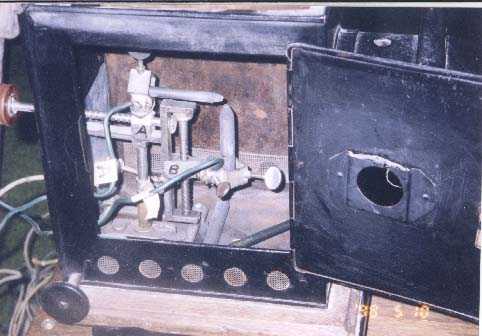
Carbon-arc Electric (AC) Lamphouse
This view shows a closeup of the carbon arcs at 90 degrees to each other. This primitive system produces a hot, slightly flickering light, which is projected out the front (right) of the lamphouse, towards the Edison Improved Exhibition Model Projecting Kinetoscope. Notice that the carbons can be safely adjusted using the brown control knob (left).
Public Showings & What's New
The most recent exhibition of the PK will be seen at the top of the list.
In late September 2012 at DobbyTown in Alliance, Nebraska, the PK was once again on display for folks' inspection. The silent film THE GREAT TRAIN ROBBERY was exhibited on 22 September 2012 to an enthusiastic crowd. Please return to this location for an update on the presentation and new parts being found for lighting, etc. Here's a link to the 2012 poster.
Here's the link to the edited B&W silent video of THE GREAT TRAIN ROBBERY as seen most recently. This 352 x 288 pixels clip runs 4:55. Enjoy.
In the What's New department, a new, more modern lighting system for the lamp house is under development. While the carbon arc lighting system will remain the backbone of the lighting system, modern lamps provide more reliable service. A 1000 watt F E L Osram Sylvania and TP220 socket are being tested as alternative lighting. Stay tuned for more on this. Suggestions as to modern lighting can be sent here.
Readers of this web page will be pleased to learn that the PK has recently appeared in public at the Dobby Town Fall (northern hemisphere case) Festival in Alliance, Nebraska, in September 2003, September 2004 and September 2005. Details of these public showings will appear here in the fullness of time. An authentic Grizold 35mm film splicer and film restoration fluid were purchased in 2004. Thanks to Dennis Lee for his assistance in procuring a solid state power supply for the lamphouse and rewiring the power leads prior to the 2005 showing in Alliance.
Also in 2004-2005, the provenance for this silent film project was digitized (some 2.3 Gb of data); a summary of that work appears here for the first time.

Here's another view of the carbon arc lamphouse, showing the carbon rods and the condensing lens on the front of the lamphouse.
A Family Mystery
Who was the Mystery Woman who appeared among my grandfather's private papers and photos? The photos were taken in the Yellowstone Park area, ca. 1903 - 1909 and one looks remarkably like the heroine of the movie THE GIRL FROM MONTANA, copyright 14 March 1907. (Kent Niver The First Twenty Years, (c) 1968, pg. 113) These films were made by William N. Selig of Los Angeles, who fled Chicago to avoid Edison's process servers.
Enon Nelson worked at Yellowstone National Park as a carpenter and plumber for the railroad company, during the winter of 1902-03, building Old Faithful Inn. We have rare photos of the construction at Yellowstone, but that's another story! Byron Nelson also recalled having been bored to tears as a teenager as his Dad and a good friend near Livingston MT, told hours of raucous stories and laughed until they were hoarse. Who was this friend from the early years of the century? Although it was true that Enon worked for a time at Yellowstone, his son, Byron Nelson, confirmed that his Dad "couldn't carry a tune in a bucket." (Personal conversation, ca. 1967)
In December 1971, I wrote to the Herald - Telegraph, Chippewa Falls, Wisconsin, to ask their readers if they'd heard of the Gem Theatre or any of the names mentioned in the newspaper clipping. In January 1972, John Myrman of Chetek WI sent me the DIETZ BATTLE OF CAMERON DAM film flyer, illustrated here. He was given the flyer by Stanley Carlson in 1922. Mr. Myrman stated that my grandfather's brother, Eli, showed this film throughout the upper midwest, ca. 1915 - 1920s.
In November 1971, Leah Burt, Assistant Archivist at the Edison National Historic site, sent me photocopies of Edison Kinetoscope owner's manuals, which enabled me to determine what parts were still missing. It appears to be the Improved Exhibition Model, without automatic shutter. (Personal correspondance, 10 November 1971). The price was $180.00, complete system with Economy Transformer (which is no where to be seen).
In numerous letters and in personal conversation, I learned that the Edison PK machine had a '30 day' single pin movement, which would wear out in a month due to the fact that it wasn't encased in an oil bath, as were later models. (Personal correspondance with Harold Neumann, 11 September 1971). He owned a mint condition 1911 print of D.W. Griffith's HIS TRUST.
In July of 1997, I visited the Cameron WI Public Library in search of information regarding the silent film DIETZ BATTLE. I stopped in Cameron to determine the location of Cameron Dam. Imagine my surprise when the librarian, Patti Becker, said, "You mean the Dietz Battle book, don't you?" "No", said I. "I refer to the Dietz Battle silent film." "Oh", said she. "I didn't realize there was a film." "Oh", says I. "I didn't realize there was a book." So, we exchanged our information. I scanned the book, and determined that the site of the Cameron Dam wasn't closeby. I gave her a photocopy of the DIETZ BATTLE film flyer.
The book, John F. Dietz Defender of Cameron Dam on Thornapple River, was written by Malcolm Rosholt and published in 1974. Mr. Rosholt lives in Rosholt WI. He confirmed meeting Eli Nelson, probably in the early 1960s, and being invited to view the film DIETZ BATTLE OF CAMERON DAM. Mr. Rosholt was conducting research for his book, but was unable to stay to see the silent film, which is apparently lost. A descendant of John Dietz lives in Boca Raton, Florida. The last remaining daughter married a fellow in Texas. The Winter WI Gazette reprinted the Dietz story a few years ago. Newly found notes of our telephone conversation :
I called him on 14 June 1998 to discuss DIETZ BATTLE OF CAMERON DAM. He said WI Gov. Blaine was part of this history. Dietz' daughter was very proud, had a diary, lived in TX. John Dietz is buried in Rice lake. His son lives in Milwaukee, John Dietz III or IV lives in Boca Raton FL. Malcolm told me that the Winter WI newspaper, The Gazette, reprinted the story. Malcolm discussed his time in China. He also said a man came to visit in the 1960s and said he had an old movie about the dam. This was when Malcolm was researching for his DIETZ BATTLE book. (Personal conversation, 14 June 1998). My efforts to contact the Dietz family for their comments continue. In 2004 I re-read Rosholt's book, thanks to the SCC Beatrice librarians who found it through inter-library loan.
A Bit of Whimsy
It was, however, the recent film, TITANIC, which prompted me to revisit this body of information at this time.
In the recent blockbuster film, TITANIC, Leonardo DiCaprio's character, Jack Dawson , tells
Kate Winslet's character, Rose, that he learned to kiss the hand of the girl while watching the kinetoscope (an early silent film technology). Jack Dawson states in TITANIC that he was from Chippewa Falls, Wisconsin, and that he'd been away from there for a year or two. We therefore calculate that as the Titantic's demise was in April 1912 that he (Jack) could have seen silent movies in Wisconsin from 1910-11 or even earlier. We know from letters and other primary source material that my grandfather, Enon, and his brother Eli, owned and operated the Gem Theatre in Chippewa Falls during those years. So, assuming that Jack Dawson told us the truth about his years in Chippewa Falls, it is very likely that he visited the only movie house in town, where he
learned how to respectively kiss the girl's hand.
My contention is that without my grandfather and his brother's business acumen, Jack Dawson would never have learned how to properly behave towards the upwardly mobile Rose, nor would they would have fallen in love, nor would there have been the TITANIC love story which we know and love today.
Therefore, in recognition of these important facts, I submit that Enon Nelson contributed an essential ingredient to the TITANIC story, and without his influence of the young Jack Dawson, there would have been no love story. Therefore, I respectfully request that ten percent of the film's net receipts are immediately owed to Enon Nelson's only namesake, his grandson, Greg Enon Nelson. I'll expect the check in the mail next week. :)
A Few Interesting Links
American Film Institute has links with history, preservation, database of titles, training, library, and more.
Library of Congress Silent Films list. 01 May1903, New York Fish Market This page will describe how to download the file.
Silent film interest groups lists organizations in Canada and USA which promote film societies, periodicals, famous stars fan clubs, and movie equipment organizations.
Jim Dietz Movie Posters. Is Jimmy a relative of the famous John F. Dietz? Stay tuned!
American Mutoscope & Biograph Co., Inc., still in business, according to Thomas Bond, President. Here's a man with an attitude!
You are viewing the file Edison2.html, the contents of which (HTML source code (provenance) and graphic images which appear at this URL) first appeared online in 1998 are Copyright (c) Greg E. Nelson.









